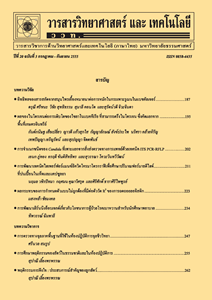เภสัชจลนศาสตร์ การกระจายตัว และการกำจัดยาออกซีเตตราไซคลินในปลาหมอไทย (Anabas testudineus)
Main Article Content
Abstract
บทคัดย่อ
งานวิจัยนี้เป็นการศึกษาเภสัชจลนศาสตร์ การกระจายตัว และการกำจัดยา oxytetracycline (OTC) ในปลาหมอไทย หลังจากการให้ยาแบบครั้งเดียว โดยฉีดเข้าช่องท้องที่ความเข้มข้น 50 มิลลิกรัมต่อกิโลกรัมน้ำหนักตัว แล้วสุ่มเก็บเลือด เนื้อเยื่อตับ ไต และกล้ามเนื้อปลา จำนวน 5 ตัว ที่เวลาต่าง ๆ หลังจากปลาได้รับยา นำไปตรวจวัดความเข้มข้นของ OTC ด้วยเทคนิค high-performance liquid chromatography (HPLC) และวิเคราะห์ค่าปัจจัยเภสัชจลนศาสตร์ พบว่าระดับความเข้มข้นสูงสุดของ OTC ในน้ำเลือด (Cmax) ของปลาหมอไทยเท่ากับ 12.25 มิลลิกรัมต่อลิตร ที่เวลาสูงสุดของค่า Cmax เท่ากับ 1 ชั่วโมง หลังจากปลาได้รับยา ปลาหมอไทยมีค่าครึ่งชีวิตของการกำจัดยา (T1/2) อยู่ที่ 44.35 ชั่วโมง พื้นที่ใต้กราฟระหว่างความเข้มข้นกับเวลา (AUC) เท่ากับ 1042.75 มิลลิกรัมชั่วโมงต่อลิตร และค่าการชำระยาทั้งหมดออกนอกร่างกาย (Clb) อยู่ที่ 0.0480 ลิตรต่อชั่วโมงต่อกิโลกรัม ซึ่งชี้ให้เห็นว่าปลาหมอไทยมีอัตราการกำจัดยา OTC อยู่ในระดับสูง โดยพบตับเป็นเนื้อเยื่อที่มี OTC ในระดับความเข้มข้นสูงสุดทุกจุดเวลาที่เก็บตัวอย่าง รองลงมาเป็นไต และกล้ามเนื้อ ตามลำดับ และผลจากการศึกษาซึ่งพบว่าความเข้มข้นของ OTC ในน้ำเลือดและเนื้อเยื่อต่าง ๆ ของปลาหมอไทยมีค่าสูงกว่าค่าความเข้มข้นต่ำสุดของยาในการยับยั้งเชื้อ (MIC) จึงสรุปได้ว่าการให้ยา OTC ที่ระดับความเข้มข้น 50 มิลลิกรัมต่อกิโลกรัมน้ำหนักตัว เป็นระดับที่มีประสิทธิภาพเพียงพอในการใช้ควบคุมโรคติดเชื้อแบคทีเรียในปลาหมอไทย
คำสำคัญ : เภสัชจลนศาสตร์; ออกซีเตตราไซคลิน; ปลาหมอไทย
Abstract
Pharmacokinetics, tissue distribution and elimination of oxytetracycline (OTC) with a single dose of 50 mg/kg body weight after intraperitoneal (IP) injection in climbing perch (Anabas testudineus) weighing about 50 g was conducted. Blood samples, liver, kidney and muscular tissues from 5 fish were sampled at different time interval after drug administration. OTC concentration in plasma and tissues was determined using high-performance liquid chromatography (HPLC) and analyzed using a non-compartmental pharmacokinetic model. The results showed that maximum plasma concentration (Cmax) of climbing perch was 12.25 mg/L and the time to peak concentration (Tmax) was 1 h after OTC administration. According to non-compartment pharmacokinetic model, elimination half-life (T1/2) of climbing perch was 44.35 h. Area under the curve (AUC) of climbing perch was 1042.75 mg.hr/L with the total body clearance (Clb) of 0.0480 L/hr/kg. It was found that administration of OTC to climbing perch performed higher rate of OTC elimination. Moreover, liver levels indicated higher OTC values than respective kidney and muscle levels at all-time points. OTC concentrations in both plasma and tissues remained above the effective treatment concentrations, which can be concluded by comparison with minimal inhibitory concentrations (MICs) as listed in literature, thus OTC with concentration of 50 mg/kg body weight can be considered as an appropriate treatment for common bacterial infections in climbing perch farming.
Keywords: pharmacokinetics; oxytetracycline; climbing perch


